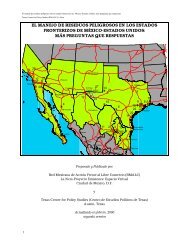Pesticides and Water Quality - Texas Center for Policy Studies
Pesticides and Water Quality - Texas Center for Policy Studies
Pesticides and Water Quality - Texas Center for Policy Studies
Create successful ePaper yourself
Turn your PDF publications into a flip-book with our unique Google optimized e-Paper software.
which pollutants to monitor <strong>for</strong> in testing the quality ofsurface water or ground water; (2) decide where to targetmore aggressive pollution reduction ef<strong>for</strong>ts; or (3)measure the effectiveness of pollution reduction ef<strong>for</strong>ts..B. <strong>Water</strong> <strong>Quality</strong> <strong>and</strong>Pesticide Data in <strong>Texas</strong>Over the past 30 years, the state <strong>and</strong> federal governmentshave developed fairly detailed data on the presence of“conventional” pollutants in surface water.“Conventional” pollutants include fecal coli<strong>for</strong>mbacteria, organic materials that create biological oxygendem<strong>and</strong> (BOD) 2 , nutrients such as nitrogen <strong>and</strong>phosphorus which increase algal growth, <strong>and</strong> suspended<strong>and</strong> dissolved solids. There is a wealth of data on thehealth of our water in relation to these conventionalpollutants. There is also quite a bit of in<strong>for</strong>mation onhow <strong>and</strong> where these types of pollutants enter ourwaterways <strong>and</strong> aquifers, though more in<strong>for</strong>mation onsome types of sources -- such as storm water run-off,septic tanks, sewage spills <strong>and</strong> ab<strong>and</strong>oned wells -- isnecessary <strong>for</strong> a complete picture. 3Much less in<strong>for</strong>mation is available on “toxic” waterpollutants, however. 4 A program introduced in 1986called the “Toxic Release Inventory” (TRI) 5 requiresmany types of manufacturing plants to report theirreleases of toxic pollutants into the water, air <strong>and</strong> l<strong>and</strong>.This program has been an important step in getting betterscientific in<strong>for</strong>mation on toxic water pollution fromindustrial operations <strong>and</strong> has allowed state <strong>and</strong> localgovernment agencies to better target monitoring <strong>and</strong>pollution control ef<strong>for</strong>ts <strong>for</strong> this sector. The TRIprogram, however, does not apply to non-manufacturingsources of toxic water pollution.One potentially important source of non-industrial toxicwater pollution is the use of pesticides—on farms, golf2 Oxygen-dem<strong>and</strong>ing pollutants are most frequently associated with sewage.Discharges high in BOD can reduce the in-stream dissolved oxygen (DO)levels. Reduced DO levels can adversely affect aquatic life.3 See <strong>Texas</strong> <strong>Center</strong> <strong>for</strong> <strong>Policy</strong> <strong>Studies</strong>, <strong>Texas</strong> Environmental Almanac,Chapter 2, <strong>Water</strong> <strong>Quality</strong> (Austin, 1995). Also available on the internet athttp://www.tec.org.4 <strong>Texas</strong> Clean Rivers Program/TNRCC, <strong>Texas</strong> <strong>Water</strong> <strong>Quality</strong>: A Summaryof River Basin Assessments (Austin: 1994), p. 38.5 For the most recent <strong>Texas</strong> TRI trends, seewww.trncc.state.tx.us/exec/media/press/06-98tri.html.2




